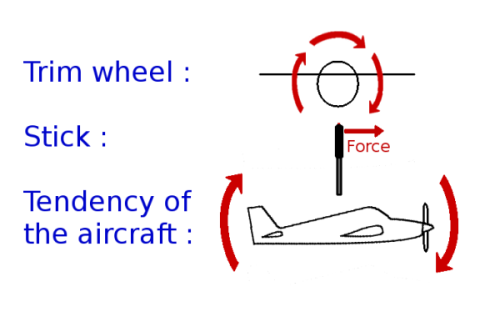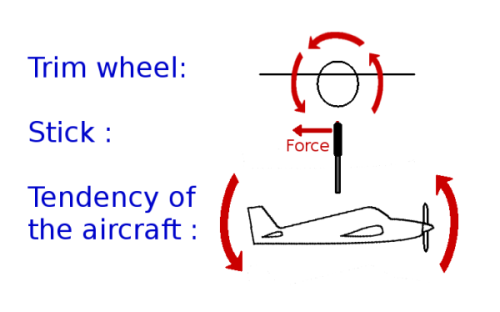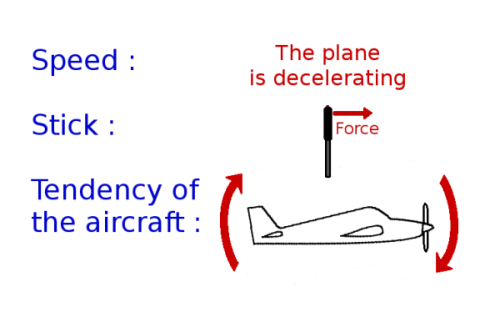



Hello again! I hope your break has made you fit because we are getting into an important chapter. I'm going to tell you about trimming the plane.
The trim is a device to help you pilot the pitch. Its function is to modify the forces you can feel from the stick.
It is controlled by a trim wheel generally located between the two seats of the pilots.
Let's see some examples where we set it wrong to understand how it works :
Turning the trim wheel forward :
The more you turn the trim wheel forward, the more the stick will push your hand forward. If you don't hold it still, your plane will stabilize a lower pitch (which is not what we want - you are piloting the plane, not the opposite) :

Turning the trim wheel backward :
On the opposite, the more you turn the trim wheel backward, the more the stick will push your hand backward. If you don't hold it still, your plane will stabilize a higher pitch.

The issue of trimming is to set the trim wheel in order to have the pitch you have chosen staying steady (without any input from you on the stick).
Thus, keeping the pitch steady will require less mental capacity, will be less tiring and much more accurate (the human body is poorly made to keep a constant strain on a device with accuracy).
Having an aircraft well trimmed will free some of your mental capacities to look out, to speak on the radio, to navigate ...
Then why don't you trim once and for all ?
The trim has been created because the strain you have to apply on the stick varies according to different factors. Let's see the main factors :
- The weight and balance of the aircraft from a flight to another (passengers, luggage ...).
- The extension or not of the flaps.
- The speed variations.
This last factor is the most important and will be the one that will make you use your trim the most often. Here are the effects of the speed variations on the stick strain and the tendency of the plane :
Deceleration :
Slowing down the plane has the same effect as turning the trim wheel forward.
Assuming that the trim wheel was correctly set before, the more you decelerate, the more your stick will push your hand forward to lower the pitch. (on the contrary, you need to keep a higher pitch in order to stay leveled with less speed).

So when the aircraft speed decreases, you will have to turn the trim wheel backward to counter the strain from the stick.
Acceleration :
Speeding up has the same effect as turning the trim wheel backward.
The more you accelerate, the more the stick will push your hand backward to make the pitch higher.

So when the aircraft speed increases, you have to turn the trim wheel forward to reduce the strain from the stick.
As the strain from the stick depends on the speed, it is useless to try to set your trim with accuracy as long as the speed is not steady.
Here is the sequence you will have to use to change pitch while staying leveled and trim the plane :
- return the throttle to idle.
- pitch up gradually (it depends on the speed of the plane).
- turn the trim wheel backward to roughly suppress the stick strains when they appear.
- just before reaching the desired speed, set the power needed to maintain this one.
- one more time, check the pitch, the power, the speed and the altitude.
- improve the accuracy of your trim setting if the speed is correct and steady.
To improve the accuracy of your trim setting, you have to release the stick slightly to see which way the pitch is going and counter this variation by turning slightly the trim wheel the opposite way.
Voila! This chapter is finished. Being able to trim your aircraft is very important, so don't hesitate to read this chapter again and to take your time.
When you feel ready, go to the next chapter to learn some helpful techniques.


